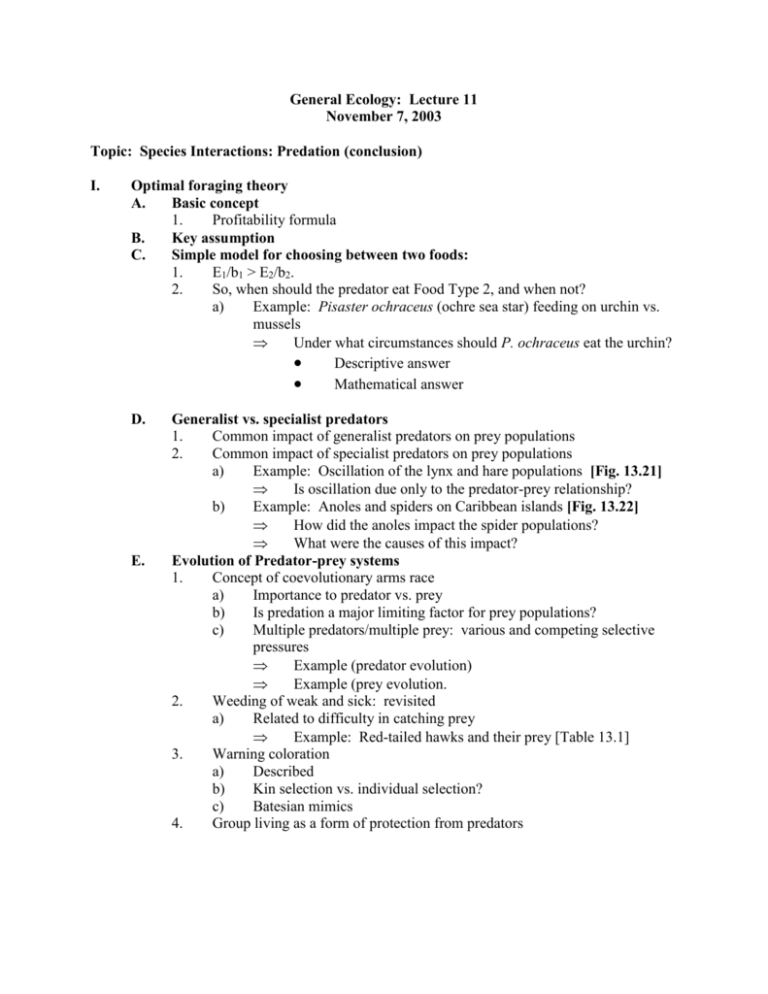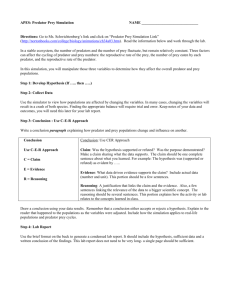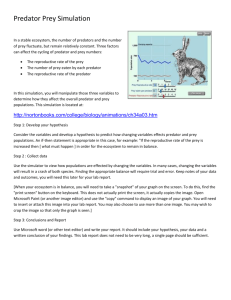Ecology03,Lec11study
advertisement

General Ecology: Lecture 11 November 7, 2003 Topic: Species Interactions: Predation (conclusion) I. Optimal foraging theory A. Basic concept 1. Profitability formula B. Key assumption C. Simple model for choosing between two foods: 1. E1/b1 > E2/b2. 2. So, when should the predator eat Food Type 2, and when not? a) Example: Pisaster ochraceus (ochre sea star) feeding on urchin vs. mussels Under what circumstances should P. ochraceus eat the urchin? Descriptive answer Mathematical answer D. E. Generalist vs. specialist predators 1. Common impact of generalist predators on prey populations 2. Common impact of specialist predators on prey populations a) Example: Oscillation of the lynx and hare populations [Fig. 13.21] Is oscillation due only to the predator-prey relationship? b) Example: Anoles and spiders on Caribbean islands [Fig. 13.22] How did the anoles impact the spider populations? What were the causes of this impact? Evolution of Predator-prey systems 1. Concept of coevolutionary arms race a) Importance to predator vs. prey b) Is predation a major limiting factor for prey populations? c) Multiple predators/multiple prey: various and competing selective pressures Example (predator evolution) Example (prey evolution. 2. Weeding of weak and sick: revisited a) Related to difficulty in catching prey Example: Red-tailed hawks and their prey [Table 13.1] 3. Warning coloration a) Described b) Kin selection vs. individual selection? c) Batesian mimics 4. Group living as a form of protection from predators Study Questions 1. What is meant by “optimal foraging”? 2. What key assumption was made in the simple optimal foraging model introduced in the text and lecture? Provide an example where this assumption doesn’t hold true. 3. Mathematically, what constitutes a “superior” vs. “inferior” prey item? 4. Under what conditions would the predator be expected to eat the inferior prey? State both in words and mathematically. 5. Is generalist or specialist predator more likely to create stability in its prey populations? Explain. 6. Is a generalist or specialist predator more likely to wipe out/create oscillations in its prey populations? Explain. 7. The oscillation in hare populations resembles the oscillation in lynx populations (as shown in Fig. 13.21) and is thought to be due to fluctuations in the lynx populations. What is an alternate hypothesis for the fluctuations in the hare population? 8. Anoles on Caribbean islands have been shown to negatively impact spiders. By what two mechanisms do the anoles affect the spider populations? 9. Why would selective pressure of a predator on its prey tend to be stronger than the selective pressure on a prey on a predator? Under what circumstances might this not be true? (Think about generalist vs. specialist predators, and other factors affecting prey abundance.) 10. Discuss the problem of evolving to be a better-equipped predator for a generalist vs. a specialist predator. Similarly, discuss the problem of evolving to be a better-equipped prey if you have one vs. several predators. [Assume that the underlying genetic variability is present in the population. Obviously, lack of that variability would impede evolution regardless of the strength of the selective pressure.] 11. Discuss the circumstances for which “substandard” individuals likely to be preferentially preyed upon (i.e. the concept of weeding out the sick and old), vs. when that is less likely to happen. Include an example. 12. Under what circumstances is kin selection likely to play a role in maintaining warning coloration (vs. when selection at the level of individuals is sufficient)? 13. Why would Batesian mimics reduce the positive effects of warning coloration? 14. Describe three anti-predator benefits of group living.








